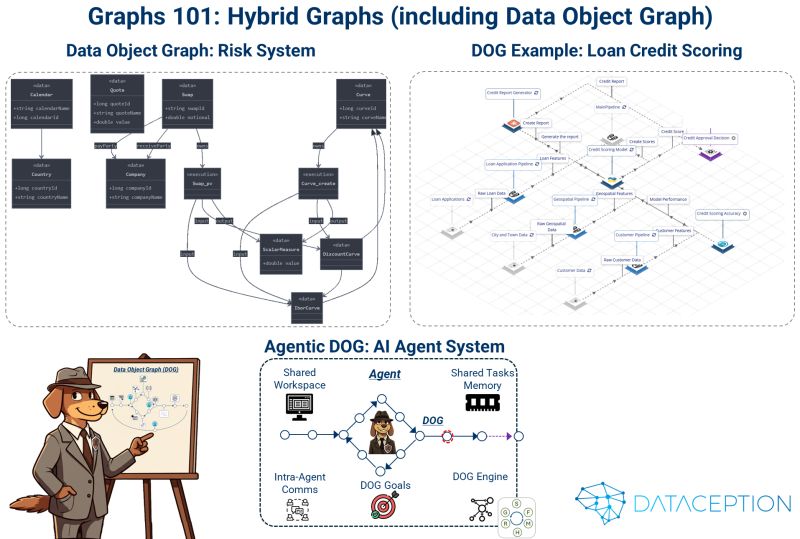As we continue our exploration of graph structures, we've covered data graphs (focused on representing relationships) and execution graphs (designed to orchestrate computations). Now we arrive at the most powerful and versatile of them all—hybrid graphs.
These are the systems where data meets execution, where knowledge isn't just represented—it's activated. And leading this charge is a new breed of graph: Data Object Graphs, or DOGs.
🌀 What Are Hybrid Graphs?
Hybrid graphs combine the strengths of data-only graphs (like knowledge graphs) with execution graphs (like those used in machine learning or data pipelines).
They go beyond describing what is connected or what to compute—they connect entities and execute logic across those connections. In doing so, they create living, intelligent systems that can react, reason, and respond in real time.
🐕 Data Object Graphs (DOGs): The Intelligent Hybrid
At the heart of hybrid graph evolution is the Data Object Graph (DOG). A DOG combines:
Data Nodes: Entities with rich attributes and relationships (e.g., a financial instrument, customer, or patient record).
Execution Nodes: Embedded functions or logic that can act upon the data (e.g., calculating risk, triggering workflows, scoring credit).
These are tied together by edges that define how data and computation flow across the graph.
💡 A Real-World Example: Risk Management as a Living Graph
Imagine a financial risk engine built entirely as a Data Object Graph.
Data Nodes:
Company: counterparty entities
Curve: interest rate curves
Swap: derivative contracts
Quote: live market data
Execution Nodes:
Curve_create: constructs yield curves from quotes
Swap_pv: calculates present value of swaps
When a market Quote changes, the graph doesn't wait for human intervention—it triggers recalculations through execution nodes in real time:
A change in Quote → recalculates Curve via Curve_create
New Curve → recalculates Swap values via Swap_pv
This transforms a static data model into a responsive, traceable, dynamic system that:
✅ Tracks provenance of every computed value
✅ Enables impact analysis instantly
✅ Responds in real-time to market shifts
✅ Supports scenario analysis by generating new graph instances on the fly (e.g., simulating a rate hike)
🌍 Beyond Finance: A Universal Pattern
This hybrid pattern extends far beyond finance.
🔧 In manufacturing, DOGs connect inventory data with production workflows.
🏥 In healthcare, they integrate patient records with treatment logic.
🏛️ In public services, they simulate process flows for permits, approvals, or benefits eligibility.
Anywhere that data meets action, DOGs thrive.
🤖 Agents on Rails: Why DOGs Matter for AI
As we enter the era of intelligent agents and LLM-powered systems, DOGs unlock a crucial capability: context with control.
AI agents operating over DOGs understand that a "customer" in Sales is different from a "customer" in Support. They operate within defined rails of business process, retaining:
Contextual awareness
Regulatory traceability
Execution consistency
We call this pattern: Agents on Rails.
It’s the sweet spot between the flexibility of generative AI and the structure of enterprise-grade systems.

🚀 The Road Ahead
As AI becomes more deeply embedded in how businesses operate, systems that merge knowledge and computation will define the new standard.
Data Object Graphs are not just another modelling technique—they’re a platform for dynamic decision-making, operational intelligence, and AI reliability.
They don’t just describe the world. They help systems reason about it and act on it—all within a shared, explainable graph.
With Dataception Ltd’s DOGs, AI is just a walk in the park. 🐾

